You can always tell the non-gardeners. They’re the ones who see the bland white butterflies with the black spots on their wings fluttering over my cabbage plants and say things like, “Ohmygosh how pretty! Butterflies!”
Poor, poor, misguided fools. They never go crazy, like I do, for the dive-bombing glint of dozens of dragonflies. They never squeal with delight over the first flight of the orchard mason bees. Nope – it’s always those damned butterflies, parents to one of the most ubiquitous garden pests in the Maritime Northwest.
Caterpillars In The Garden
Caterpillars are the larva (babies) of moths or butterflies, and they are notoriously very hungry. It takes a lot of food for squiggly larva to build up enough energy to metamorphose into something with wings and a penchant for fluttering.
When the food is milkweed and the result is the awe-inspiring migratory Monarch butterfly, we have an insect people will move heaven and earth to save (even if sometimes it seems our best intentions just pave the way to hell.)
When the food is MY broccoli seedlings, or acres of commercial cabbages, and the insect is a bland, camouflaged green worm-thing, you have a major agricultural pest. The devil is in the details.
Imported Cabbageworm
One of the most ubiquitous and damaging pests in my garden, where cole crops are grown year-round, is the Imported Cabbageworm. He’s a fuzzy little bastard perfectly camouflaged to blend in against a cabbage leaf. Like this:
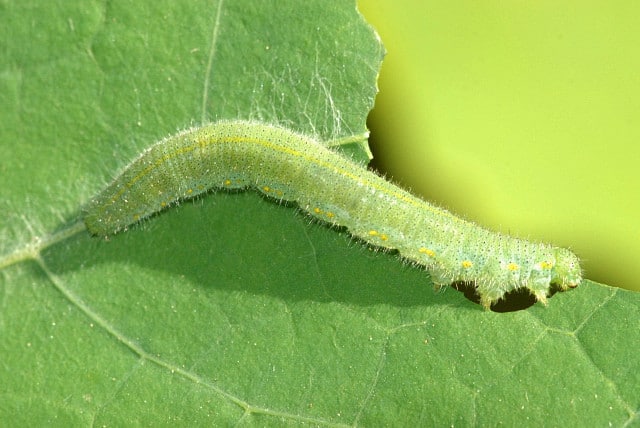
Who It Is
The Imported Cabbageworm is the larvae of the butterfly Pieris rapae, usually called the Cabbage White or the Small White. This is a white butterfly with black spots on its wings. As you’d guess from the name Imported Cabbageworm, the Cabbage White is not native to North America, but at this point you can find it nearly world wide.

What It Does
Eat all the brassicas! The Cabbage White will lay eggs on almost any wild or cultivated member of the brassica family. (Brassicas include cabbage, broccoli, cauliflower, kale and more.) The eggs are laid on the underside of leaves where they are hidden from the gardener’s view. Unless you know to look for them, they are easy to miss.
When these eggs hatch out, the larvae – the Imported Cabbageworm – start munching their way through their brassica host, and they do not stop eating until they are ready to pupate, some 2 to 3 weeks later, depending on time of year.
The Imported Cabbageworm is very destructive because he just eats so dang much, leaving skeletonized leaves in its wake. He’ll happily chew his way into the center of a cabbage or head of broccoli, making the vegetable commercially unmarketable. Ignoring the good advice of HR professionals everywhere, the Imported Cabbageworm also shits where he eats, covering brassicas with goopy frass as it digests its way through its host.
This brassica seedling has been turned into green balls of caterpillar digestion. Ick.
How To Control Cabbageworm
The Imported Cabbageworm is, thankfully, very easy to control. Here are several ways to thwart this pest in your garden.
Protect Your Seedlings with Row Cover
This is the barrier method of Cabbageworm control. The idea is – if you prevent the Cabbage White access to your brassica plants, she can’t lay eggs and you’ll never have to deal with the Imported Cabbageworm.
If you are diligent about covering a newly transplanted brassica bed with lightweight floating row cover or fine insect netting this method works extremely well.
Early Detection: Hunt and Destroy
If you have a small garden, handpicking Cabbageworms can be very effective – if you can find them. A week or so after you see the Cabbage White fluttering around your garden beds, go out and look very closely at the leaves of your plants.
The Cabbageworms start out very small – look for a green ridge, usually on the undersides of your brassicas’ leaves, about the size of a grain of rice. They grow quickly to about an inch long. At this point, it’s easier to see them but they’ve already done a lot of damage. Just squish the little ones right against the leaves if you aren’t squeamish. Big ones make excellent chicken food.
Check over your broccoli, cabbage and cauliflower weekly for the caterpillars.
Encourage Natural Enemies
The truth is, there are many creatures out there who are better at finding caterpillars than you are, and probably more motivated to do so. In the spirit of, “the enemy of my enemy is my friend,” we want to encourage these natural predators.
(Learn more: Three Simple Steps To Bring Beneficial Insects To Your Garden.)
Wasps
The year Bald Faced Wasps made a nest in my garden I had almost no Cabbageworm damage to my plants.
Braconid Wasps
Braconid Wasps don’t sting, sip nectar and are extremely polite in the garden. That is, unless you are a cabbageworm – then they just seem like freaky, torture-loving sadists. Braconids are parasitic. They lay their eggs inside a living host species. Cabbageworms and tomato hornworms are both targeted.
The wasp larvae eat their way through the living host, slowly devouring it from the inside-out, and eventually killing it. (Nature is not sentimental.) This is a grotesque end if you are a caterpillar, but Braconids are some of the most useful beneficial insects you can attract to your garden.
Tachinid Flies
Very similar to Braconid Wasps, Tachinid Flies are also parasitic predators to caterpillars.
Other Beneficials to Encourage:
- Birds – Numerous birds think caterpillars are a delicious tasty treat. In spring, birds will hunt and bring cabbageworms back to the nest to feed
- Assassin bugs – These red predatory insects will hunt down cabbageworms and eat them like an eclair.
- Lacewings
- Ground beetles
- Spiders
Insecticides
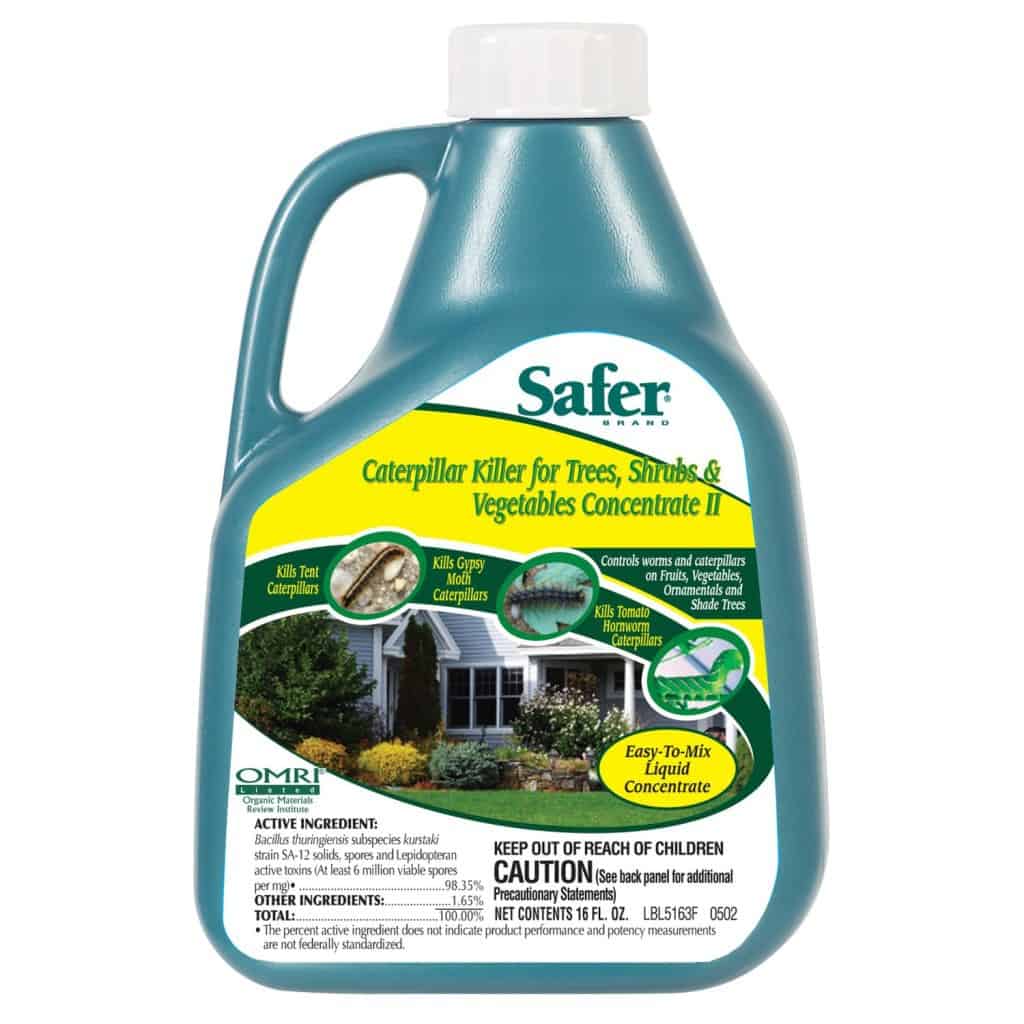
The Imported Cabbageworm can be managed extremely effectively with a targeted, biological, organically approved insecticide called Bacillus thuringiensis subspecies kurstaki (Btk).
Bt (pronounced “Bee Tee”) is one of only two insecticides I use in my garden. (The other is Sluggo.) It’s organically approved, and quite interesting. The Bt itself is a special strain of bacteria, not a chemical insecticide. It paralyses the gut of caterpillars who eat treated leaves. The caterpillars stop eating soon after ingesting the Bt-treated leaves, and die within a few days.
Bt is very effective against caterpillars, but non-toxic to bees and other, non-caterpillar beneficials. It’s safe to use around kids, pets, etc.
You can buy Bt online – I use a liquid Bt concentrate – but there are also Bt dusts available. Well stocked garden stores will sell Bt as well – just ask for “Bee Tee” and they’ll show you to the right area.
Bt breaks down in bright, sunny weather, so for complete control, you’ll need to apply it a few times during the growing season. Commercial growers might spray weekly during times of high pest pressure. In combination with the other, non-insecticidal controls listed above, I find I need maybe two targeted sprays of Bt – once in the spring about a week after I first see the Cabbage White, and one in mid-summer, is usually enough to keep populations of the Imported Cabbageworm low in my garden.
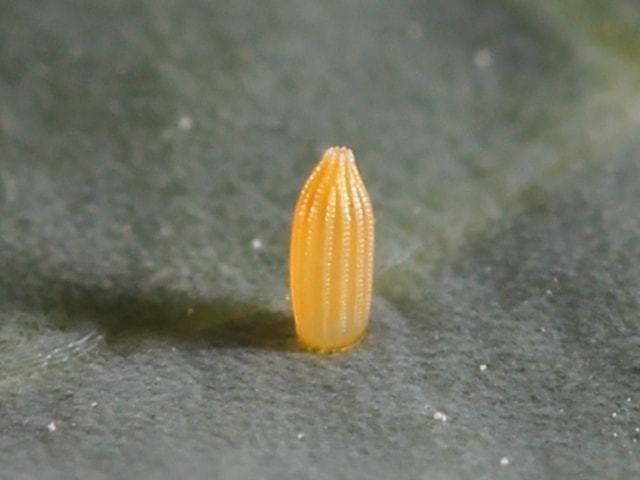

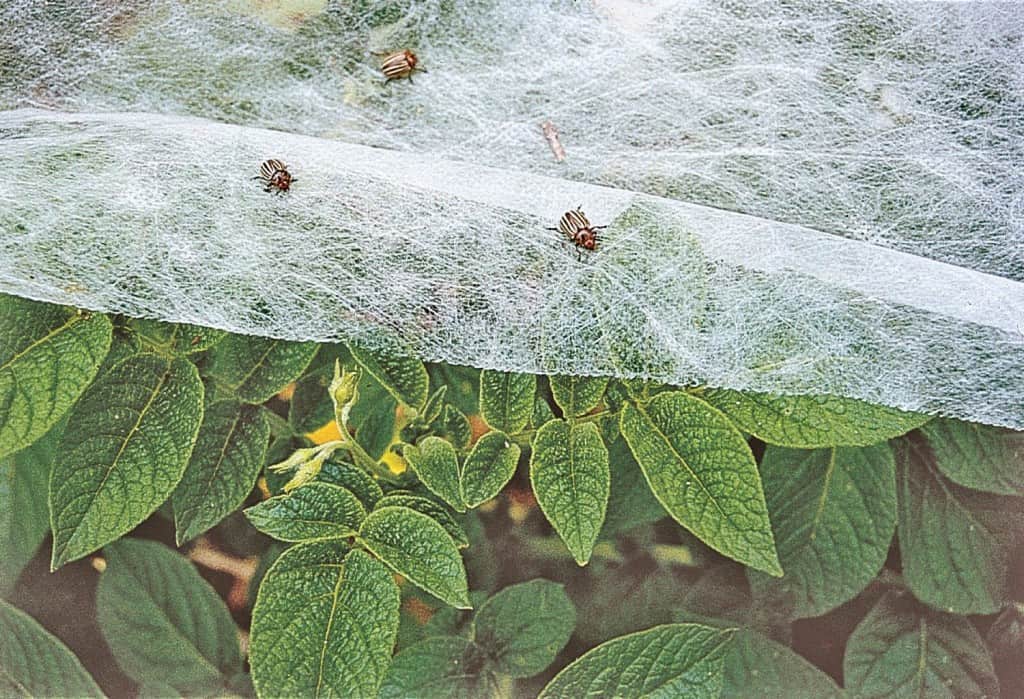
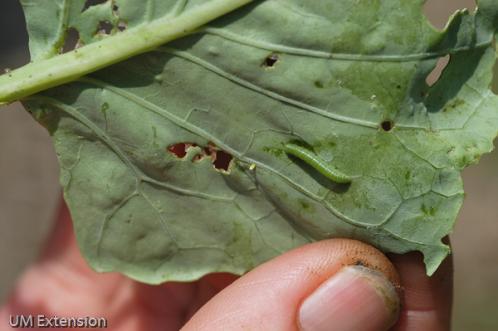

I have had good luck with pouring milk soured with a little vinegar over heads of cabbage. The only problem was the dog age a whole head of cabbage before he was banned from the garden.
We have been stumped for several years, and have simply avoided planting the brassica family. Thank you very much. We are excited about having some brassica this year!
An tip that we tried last year was keeping egg shell bits around the plants. Seemed to work. The guess as to why was that the adults mistake the white for other adults and leave the territory – who knows?
Row cover works great, at least until my plants get so tall the butterflies start getting underneath the edges. I also keep a badminton racket hanging in my hoop house to swat the nasty butterflies 🙂 I pick them off too, and leave a lot to the wasps, but have found Bt very useful for an application or two when they get really ahead of me, and for fall crops that seem to get hit earlier.
We had a really harsh winter in 2013-24 in WI and these were a pest affected by the freeze: last summer the population was way down, which was so nice! We also have a newish prairie planting area that attracts a lot of wasps, and I’m glad for this reminder of another benefit of native plants is all the “good guys” you bring into your garden!
Brilliant pictures! I remember my father dousing my city child enthousiasm for pretty white butterflies by telling me they were a dreadful pest. Dad was not a gardener but he liked knowing things and teaching things.
Are Braconid Wasps the same ones that go after Mason Bee larvae as well?
Yes I have seen these little terrorists already this spring. I tried to use floating row covers last fall but I don’t think I set it up right. I lifted the cover and found skeleton cauliflower and Brussels. So instead of a barrier to keep them out its like I gave them a protective layer to really go to town. So I’ve given up on growing brassicas for now, my garden is pretty small anyway and they need so much room.
My current public enemy #1 is flea beetles and my poor baby arugula they are destroying. Have you ever had problems with them?
So helpful- thanks! How long do you keep the row cover on? Are plants less susceptible once they are bigger? Also, my biggest problem on brassicas seem to be aphids- any tips for those suckers? You’re the best Erica!
Last year was absolutely horrible here in the Oregon City area for cabbage worms. Dreadful white rage-inducers were everywhere, and their demon spawn showed up in ever-more-disgusting ways. I almost swore off brassicas and coles entirely because it was so frustrating. This year I am using a floating row cover, So far, with the early spring, my cabbages and broccoli plants are huge and gorgeous. I am praying the row covers keep them that way!
I had cabbage worms so badly last year. They were all over my cabbage and kale, and I didn’t know what to do about them. I think those wasps you mentioned actually did come to my garden, because I remember seeing one of the cabbage worms with eggs stuck to it, just kind of hanging from a cabbage leaf. It was weird.
This is the point where I wonder if I should admit that I pick them off the plants, drop them on the soil and stab them over and over with a little twig until they burst green goo all over. Sick and twisted, yes. Also gross. And rather effective if you don’t have acres of brassicas.
I hadn’t read about planting milkweed for the Monarchs and I certainly hadn’t read about the horrific backlash!
WOW. Thank you for sharing.
Oh the green beast-may he feed our friends well.
It was so satisfying last year to feed pests like this to my new neighbor’s chickens. Sadly, the chickens are no more and I’ve taken to drowning pests in my beer traps instead. It’s not nearly as fun as feeding excited chickens. Thanks for these tips! As a new gardener half the battle is figuring out what’s a pest and what’s actually trying to be helpful.
I had to click over to your Bald-Faced wasp post to see if we have any of those, but we don’t. We just have paper wasps, and lots of them. I let many nests be built in one greenhouse several years ago, but decided that they didn’t really DO anything helpful, so now they all go. Better yet, I’ve found that I have at least one of five hens who LOVES to eat paper wasps, and the other gals will go for any not-yet-wasps in the nests. With plenty of foggy mornings I’ve had good luck scraping of the nests and attached protective too-cold-to-fly yet wasps into a shallow pail of water that gets poured out in the coop and we’re all happy campers.
Ah, but this post was about cabbage worms and butterflies. Typically I try to plant enough to share, not mind the holes, squish or pick off the worms I see, and I’ve been known to throw my neck and back out of alignment trying to use a butterfly net on the parents (to also feed to the chickens). Boy those things have great non-predictable flight patterns!
yay! i use Safer also… it’s the only thing i use..and only when i need it. i try to do early broccoli before those stupid butterflies show up. thanks for the tips!
🙂
Erica, thanks so much for a great post. I have row covers in place and the Bt is standing by.
You’re the best, thanks again!
My favorite beneficial is Soldier Beetles. I’ve watched them clean up an entire plant of aphids in one afternoon. I haven’t had cabbageworm too badly yet, maybe because we have a lot of wild birds? The abundance of birds here was a big deciding factor where we bought our house!
A gardener near me has recommended planting Land Cress as a sacrificial plant – the caterpillars much prefer it to your other brassicas. Trying it this winter. http://jerry-coleby-williams.net/2014/11/01/nannys-cabbage-companion-confirmed-caterpillar-killer-by-university-of-queensland/
Fantastic Article!
People never seem to know enough about these beautiful creatures and how to control them!
I have had success with a combination of keeping everything covered with row covers and a Nasturtium death trap. I have a big, uncovered bed of “sacrificial” Nasturtium on the outskirts of my garden that is sprayed with BT. The worms are attracted to the easy target, feast, and DIE DIE DIE!! >:O
Re: worms/caterpillars, but OT probably, I have a jostaberry bush that’s totally defoliated every year by the sawfly larva. Too busy to take action, I did see that a delightful local garden guru, Jason Moorhead – of ‘The Real Garden’ on Seattle public cable station, found that regular Bt didn’t work on this particular family of insects. However, he thoroughly covered the plant, at the early ‘nibble’ stage, with insecticidal soap to which he’d added cold pressed neem oil. And that seemed to work. I’ll try it next spring. (A few chickadees were flitting about in the bush earlier, so there are actually some sizeable berries right now. Maybe the sawfly larva tastes awful?)
Re: flea beatles, I don’t have any (yet) but remember someone saying that putting a shiny surface under your plant confused them as to which way is up and down. I’m stockpiling empty chip bags that have the very shiny inside… and enjoying the chips with a clean conscience.
Re: bald faced wasps, I had a 6′ high, small ‘roof’ over a scrap wood storage area, that I visited only sporadically. It wasn’t until I was banging the wood around, that I got stung three times. THEN I noticed the very large, exquisite ‘paper’ nest hanging from the roof, that had been inches from my passing head for some time, apparently. They never bothered the oblivious me, until I ‘attacked’ them 😉 I’d like to apologize to them and invite them to select another ‘building site’… outside of our buildings, of course 😉
Gardening is such an adventure! who needs to travel 🙂
Yikes and haha! I recently wrote a post entitled “How to Feed a Caterpillar.” And I am a gardener who does say, “OMG there are butterflies!” And even more crazy…I spent the morning photographing a cabbage white laying eggs on my cauliflower and broccoli! I’m in the south where the brassicas are going to seed because it has gotten too hot, so I’m allowing the butterfly moms to have their way. While cabbage whites are crop pests, so are giant swallowtails, black swallowtails, and a whole host of other butterflies! But butterflies are very important to our food supply (as pollinators) and environment as a whole. So grow a bunch for yourself and grow a few for the multitudes of insects that make our world go round! Happy gardening. ~Julie
I’ve heard that diatomaceous earth works to pierce the bodies of the green wigglers. I’m trying it. Any info on that?
Hi Erica, Caterpillars were affecting the maple trees which I was growing in my backyard. I used a few other pesticides but was not effective. So I tried the BTK insecticide like you suggested. It has been very effective on the caterpillars and has helped to cut down the population as well.
Bok Choy is a wonderful companion plant, if you don’t want any bok choy. The worms prefer the bok choy instead of the bassicas. I used to plant it just to deter the cabbage worms.
Having read this I believed it was rather enlightening. I
appreciate you finding the time and effort to put this
information together. I once again find myself spending
a lot of time both reading and leaving comments.
But so what, it was still worth it!